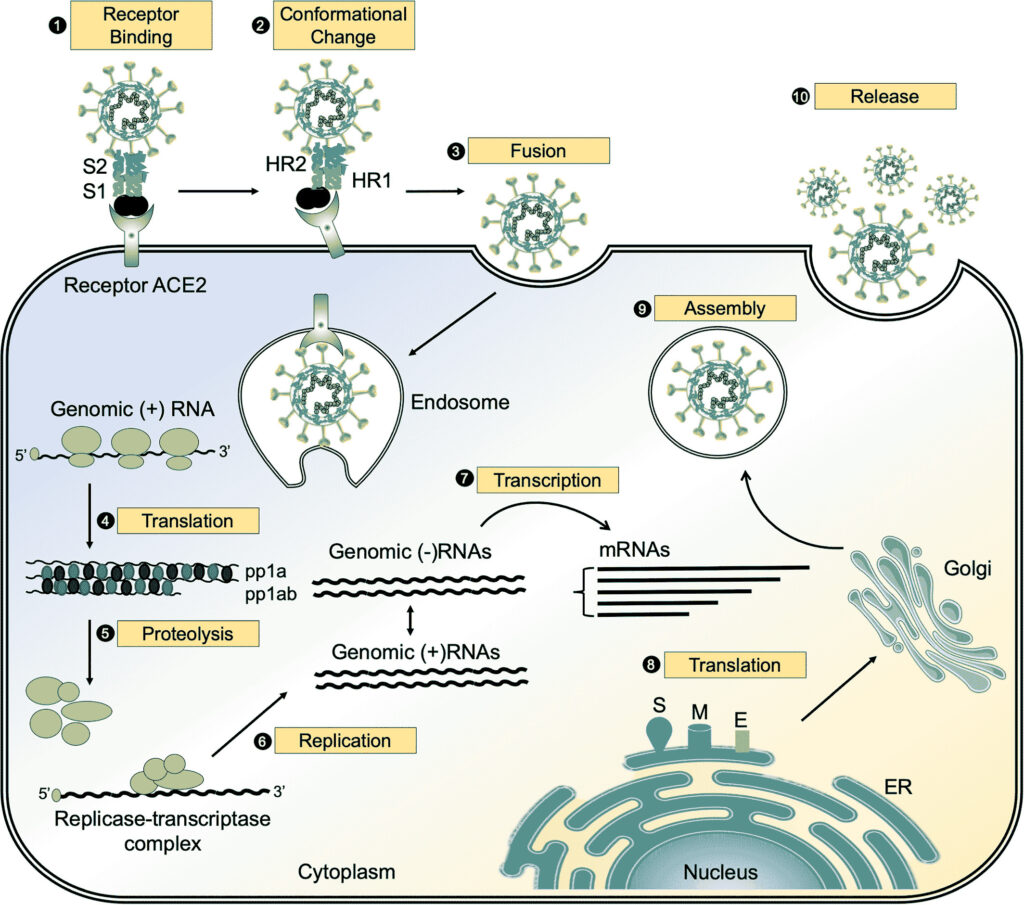Sars-Cov-2 virus
You need to remember what we came to know about this SARS-C0v-2 virus throughout the last fourteen month where we became acquainted with it. In this segment, we will review two key elements of the virus;
- Replication
- Lethality
REPLICATION
Replication refers to the multiplication of a virus. Sars2-Cov-2 virus is an mRNA coronavirus. Like any other virus it is a mandatory parasite, meaning it needs an host cell to survive and replicate itself. It absolutely needs to enter the host cell in which it will multiply, using the cell’s machinery. This infection will cause many symptoms into the host as the immune system tries to fight this invader and build immunity against it.
Here is how SARS-Cov-2 virus does the deed in a human cell.

- Spike protein on the virion binds to ACE2, a cell-surface protein. TMPRSS2, an enzyme, helps the virion enter (1-2-3) The virion releases its RNA (4)
- Some RNA is translated into poly proteins PP1A and pp1B by the cell’s machinery (4)
- These proteins are cleaved (cut) by proteases this is called proteolysis (5)
- This proteolysis creates 16 non structural proteins that forms the RNA replicase-transcriptase complex (6)
- This complex drives the production of negative-sense RNAs [(−) RNA] Replication: full-length (−) RNA copies of the viral genome are produced and used as templates for full-length (+) RNA genomes. Transcription: a subset of 7–9 sub-genomic RNAs, including those encoding all structural proteins, is produced through discontinuous transcription.
- Viral nucleocapsids are assembled from genomic RNA and N protein in the cytoplasm, followed by budding into the lumen of the ERGIC (endoplasmic reticulum (ER)–Golgi intermediate compartment. ( 8-9 )
- Virions are then released from the infected cell through exocytosis. (10)
Sources: Song et al., ‘Viruses’, 2019; Jiang et al., ‘Emerging Microbes and Infections, 2012; ‘The Economist’.
LETHALITY
The actual lethality of the infection itself is major element to be aware of. Since its first manifestation in 2019, SARS-Cov-2 infectious disease has claimed the lives of millions, acquiring the reputation of being a deadly virus. In fact 99.92% of the population infected recovered from it.
.tmb-1920v.png?sfvrsn=afa995ff_1)
Depending on the demographic, the risk of mortality varies; the table below illustrates the fatality rate of different age groups from four different countries
Amongst the death, comorbidities were seen at different rates:
- Diabetes (45%),
- Sustained hypertension 32%,
- Coronary artery disease (12.3%),
- Renal disease (8.2%)
The SARS-Cov-2 infection is one that hits mostly the vulnerable individuals or systems. Highlighting their fragility in terms of health, socio-economic, hitting the most deprived; of nourishment, finance or resources. Therefore one way to control the infection would be to solidify these fragile and vulnerable elements.
